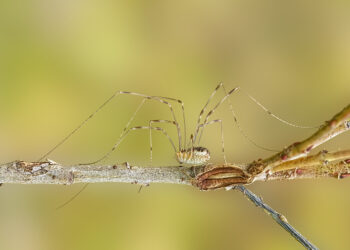Nature is full of cunning trickery, but few are as audacious as the blow fly. Imagine not only altering your smell and chemical profile but even growing a fake face on your butt just to infiltrate a termite nest. In a remarkable discovery, researchers found that blow fly larvae can successfully evade detection within harvester termite colonies, benefiting from the nest’s protection as they develop.

The larvae of certain blow fly species have evolved an astonishing ability to mimic termites. They take up residence in the nest but don’t appear to prey on termites or disrupt their activities — they’re simply living among them undetected. This behavior, known as social parasitism, occurs when one species exploits the social structure of another. While various insects engage in this strategy, the blow fly seems to take it to the extreme.
The discovery happened by chance in Morocco’s Anti-Atlas mountain range, highlighting the unpredictable nature of scientific exploration.
“This is a chance finding. In our research group we mainly study butterflies and ants. As it had rained a lot and the butterflies were not flying, we looked for ants. When we lifted a stone we found a termite mound with three fly larvae that we had never seen before. The water had probably flooded the deeper layers of the nest and the larvae had emerged onto the surface,” says Roger Vila, the IBE researcher who led the study.
“It must be an extremely rare species, because we have made three more expeditions in that area and, despite lifting hundreds of stones, we found only two more flies, together, in another termite mound.”
A disguise like no other
The first thing that caught the researchers’ attention was the larvae’s bizarre morphology. Their rear end mimics the head of a termite, complete with what appear to be antennae and false eyes. However, these ‘eyes’ are actually the larvae’s breathing holes (spiracles).
This disguise is crucial because, unlike most termites that live deep underground and are blind, harvester termites can see.
“Most termites live several metres deep and have no visual perception. However, harvester termites come out at dusk to collect grass, so they have functional eyes that the larvae are able to mimic with their spiracles”, says Vila.

Even though harvester termites can see, their primary form of identification relies on scent and antennae contact. When researchers examined the larvae’s fake antennae under a scanning electron microscope, they discovered an astonishing level of detail. They closely resemble real termite antenna — but that’s not all. The larvae also mimic the unique odor profile of the termites, an essential trick for blending in.
“We quantified the chemical composition of these larvae and the result is surprising: they are indistinguishable from the termites in the colony where they live; they smell exactly the same. In addition, the larvae and termites in a particular colony have slight differences in their chemical profile that differentiate them from other termite mounds. This odour is key to interacting with the termites and benefiting from their communal life. It is a chemical disguise.”
What the larvae are doing in the termite nest
When the team first encountered the larvae, they were residing in the food chambers — a strategic location. Surprisingly, they were also found in the densely populated areas of the nest, where they regularly interacted with termites and may have even communicated with them.
“The larvae are not only tolerated, but they constantly communicate with the termites through contact with their antenna-like tentacles. The termites even seem to feed them, although this has not yet been unequivocally demonstrated”, explains Vila.
The researchers also took a termite nest into the lab, but the behavior of both the termites and the larvae seemed to change and they didn’t do so well.
The researchers note that this could still be a case of symbiosis, where the fly larvae offer something to the termite nest as well, though this has not yet been demonstrated.
“This discovery invites us to reconsider the limits and potential of symbiotic relationships and social parasitism in nature. But, above all, we should realise how much we still do not know about the vast diversity and specialisation of insects, which are essential organisms in ecosystems”, concludes Vila.
Journal Reference: Schär S, Talavera G, Dapporto L, et al. Blow fly larvae socially integrate termite nests through morphological and chemical mimicry. Current Biology. 2024; https://doi.org/10.1016/j.cub.2025.01.007






